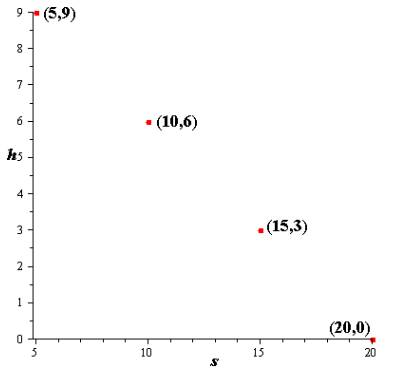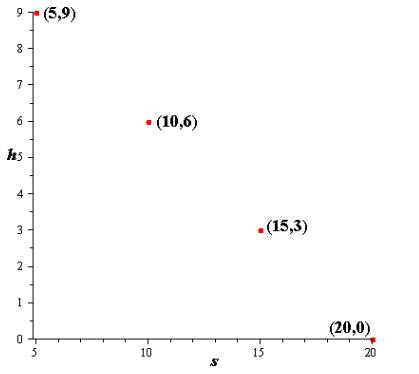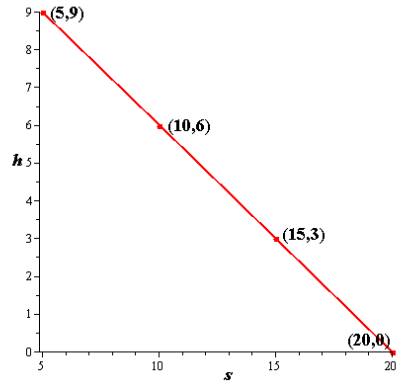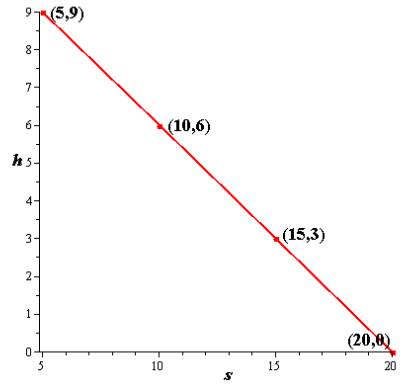
Concept explainers
(a)
To plot:the ordered pairs in a Cartesian plane.
(a)
Answer to Problem 52AYU
The Cartesian plane is:

Explanation of Solution
Given:
| Soda, | Hot Dogs, |
Explanations:
Let us consider the following table
| Soda, < | Hot Dogs, |
The ordered pairs

Conclusion:
Therefore, theordered pairs are plotted.
(b)
To show:number of hot dogs purchased is a linear function of the number of sodas purchased
(b)
Answer to Problem 52AYU
Hence, number of hot dogs purchased is a linear function of the number of sodas purchased
Explanation of Solution
Proof:
If average rate of change is constant then function is linear.
Hence, find average rate of change of the function at different points as
| point | Average rate of change,
|
| |
| |
|
It is clear that the average rate of function is constant; hence number of hot dogs purchased is a linear function of the number of sodas purchased
Conclusion:
Hence, number of hot dogs purchased is a linear function of the number of sodas purchased.
(c)
the linear function which describes the relation between
(c)
Answer to Problem 52AYU
Hence, the linear function that describes the relation between
Explanation of Solution
Calculation:
To determine the linear function describing the relation between
The equation of the line passing through two points
Similarly, equation of line passing through
Where
Hence, the linear function that describes the relation between
Conclusion:
Hence, the linear function that describes the relation between
(d)
To find: the implied domain of the linear function
(d)
Answer to Problem 52AYU
Hence, the implied domain of the linear function is
Explanation of Solution
Explanations:
The graph of the linear function cannot be negative; therefore, the graph will terminate there where it becomes zero.
Hence, the implied domain of the linear function is
Conclusion:
Hence, the implied domain of the linear function is
(e)
To graph: the linear function found in part (a).
(e)
Answer to Problem 52AYU
The graph of the linear function is:

Explanation of Solution
Calculation:
The graph of the linear function in the Cartesian plane drawn in part (a) is as follows

Conclusion:
The graph of the linear function is drawn.
(f)
To interpret:the slope.
(f)
Answer to Problem 52AYU
Hence, slope of the function
Explanation of Solution
Calculation:
The linear function is to the form
Hence, slope of the function
Conclusion:
Hence, slope of the function
(g)
To interpret:the values of the intercepts.
(g)
Answer to Problem 52AYU
Explanation of Solution
Calculation:
The
Hence,
Conclusion:
Hence,
Chapter 3 Solutions
Precalculus
Additional Math Textbook Solutions
A First Course in Probability (10th Edition)
Thinking Mathematically (6th Edition)
A Problem Solving Approach To Mathematics For Elementary School Teachers (13th Edition)
Elementary Statistics: Picturing the World (7th Edition)
Elementary Statistics (13th Edition)
College Algebra with Modeling & Visualization (5th Edition)
- HW: The frame shown in the figure is pinned at A and C. Use moment distribution method, with and without modifications, to draw NFD, SFD, and BMD. B I I 40 kN/m A 3 m 4 marrow_forwardLet the region R be the area enclosed by the function f(x)= = 3x² and g(x) = 4x. If the region R is the base of a solid such that each cross section perpendicular to the x-axis is an isosceles right triangle with a leg in the region R, find the volume of the solid. You may use a calculator and round to the nearest thousandth. y 11 10 9 00 8 7 9 5 4 3 2 1 -1 -1 x 1 2arrow_forwardLet the region R be the area enclosed by the function f(x) = ex — 1, the horizontal line y = -4 and the vertical lines x = 0 and x = 3. Find the volume of the solid generated when the region R is revolved about the line y = -4. You may use a calculator and round to the nearest thousandth. 20 15 10 5 y I I I | I + -1.5 -1 -0.5 0.5 1 1.5 2 2.5 3 -5 I -10 -15 I + I I T I I + -20 I + -25 I I I -30 I 3.5 4 xarrow_forward
 Calculus: Early TranscendentalsCalculusISBN:9781285741550Author:James StewartPublisher:Cengage Learning
Calculus: Early TranscendentalsCalculusISBN:9781285741550Author:James StewartPublisher:Cengage Learning Thomas' Calculus (14th Edition)CalculusISBN:9780134438986Author:Joel R. Hass, Christopher E. Heil, Maurice D. WeirPublisher:PEARSON
Thomas' Calculus (14th Edition)CalculusISBN:9780134438986Author:Joel R. Hass, Christopher E. Heil, Maurice D. WeirPublisher:PEARSON Calculus: Early Transcendentals (3rd Edition)CalculusISBN:9780134763644Author:William L. Briggs, Lyle Cochran, Bernard Gillett, Eric SchulzPublisher:PEARSON
Calculus: Early Transcendentals (3rd Edition)CalculusISBN:9780134763644Author:William L. Briggs, Lyle Cochran, Bernard Gillett, Eric SchulzPublisher:PEARSON Calculus: Early TranscendentalsCalculusISBN:9781319050740Author:Jon Rogawski, Colin Adams, Robert FranzosaPublisher:W. H. Freeman
Calculus: Early TranscendentalsCalculusISBN:9781319050740Author:Jon Rogawski, Colin Adams, Robert FranzosaPublisher:W. H. Freeman
 Calculus: Early Transcendental FunctionsCalculusISBN:9781337552516Author:Ron Larson, Bruce H. EdwardsPublisher:Cengage Learning
Calculus: Early Transcendental FunctionsCalculusISBN:9781337552516Author:Ron Larson, Bruce H. EdwardsPublisher:Cengage Learning





